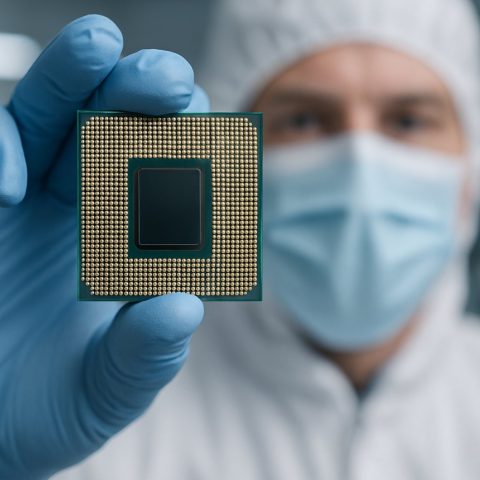The Power Players: 100 Semiconductor Giants Driving the Modern Tech Revolution
- Global Semiconductor Market Overview
- Emerging Technology Trends in Semiconductors
- Competitive Landscape of Leading Semiconductor Firms
- Growth Forecasts and Industry Projections
- Regional Analysis of Semiconductor Industry Hubs
- Future Outlook for Semiconductor Advancements
- Key Challenges and Strategic Opportunities Ahead
- Sources & References
“Ultimate Guide to Online Digital Marketing and Tools Introduction: What Is Online Digital Marketing?” (source)
Global Semiconductor Market Overview
The global semiconductor industry is a cornerstone of modern technology, enabling advancements in computing, communications, automotive, healthcare, and countless other sectors. In 2023, the worldwide semiconductor market was valued at approximately US$527 billion, with projections to surpass US$624 billion in 2024 as demand for advanced chips accelerates.
At the heart of this industry are 100 semiconductor giants that drive innovation, production, and supply chains worldwide. These companies span the entire value chain, from design and fabrication to packaging and testing. The top players include:
- TSMC (Taiwan): The world’s largest contract chipmaker, responsible for over 50% of global foundry revenue.
- Samsung Electronics (South Korea): A leader in memory chips and advanced logic semiconductors.
- Intel (USA): A dominant force in microprocessors and data center solutions.
- Qualcomm (USA): The top supplier of mobile chipsets and wireless technologies.
- NVIDIA (USA): Renowned for GPUs powering AI, gaming, and data centers.
- Broadcom (USA): Specializes in networking, broadband, and storage semiconductors.
- Micron Technology (USA): A major player in DRAM and NAND memory.
- Infineon Technologies (Germany): Focused on automotive, power, and security chips.
- STMicroelectronics (Switzerland/France): Supplies sensors, microcontrollers, and power devices.
- Renesas Electronics (Japan): Key supplier for automotive and industrial semiconductors.
These industry leaders, along with dozens of other influential firms such as AMD, Sony Semiconductor, and NXP Semiconductors, collectively shape the technological landscape. Their innovations underpin everything from smartphones and cloud computing to electric vehicles and smart factories. As the world transitions to AI-driven applications and the Internet of Things (IoT), the role of these 100 semiconductor giants will only become more pivotal in powering the modern world.
Emerging Technology Trends in Semiconductors
The semiconductor industry is the backbone of modern technology, powering everything from smartphones and data centers to electric vehicles and artificial intelligence. The sector is dominated by a mix of established giants and rapidly growing challengers, each contributing to the global supply chain and technological innovation. As of 2024, the top 100 semiconductor companies collectively account for the vast majority of the world’s chip production, research, and development.
Leading the pack are companies like TSMC (Taiwan Semiconductor Manufacturing Company), which holds over 50% of the global foundry market share, and Samsung Electronics, a leader in memory chips and advanced logic. Intel remains a dominant force in CPUs and data center solutions, while NVIDIA and AMD drive innovation in graphics processing and AI accelerators (Gartner).
- TSMC: The world’s largest contract chipmaker, crucial for advanced nodes (3nm, 5nm) used in Apple, AMD, and NVIDIA products.
- Samsung: Leading in DRAM, NAND flash, and logic chips, with significant investments in next-gen fabrication.
- Intel: Expanding into foundry services and AI chips, with a focus on regaining process leadership.
- NVIDIA: Dominates AI and high-performance computing with its GPUs, recently surpassing $1 trillion in market cap (CNBC).
- Broadcom, Qualcomm, Texas Instruments, and Micron: Key players in wireless, analog, and memory solutions.
Other notable companies in the top 100 include Infineon (automotive and power semiconductors), STMicroelectronics (IoT and industrial chips), and Renesas (embedded solutions). The full list spans global leaders from the US, South Korea, Taiwan, Europe, and China, reflecting the industry’s international scope (IC Insights).
These 100 semiconductor giants are not only driving technological progress but also shaping the geopolitical landscape, as nations invest heavily in domestic chip production to secure supply chains and foster innovation.
Competitive Landscape of Leading Semiconductor Firms
The semiconductor industry is dominated by a select group of global giants whose innovations and manufacturing prowess underpin the digital infrastructure of the modern world. These 100 leading semiconductor companies span the United States, Asia, and Europe, collectively driving advancements in computing, communications, automotive, and consumer electronics.
Market Leaders and Revenue Rankings
- Samsung Electronics and Intel consistently vie for the top spot in global semiconductor sales, with 2023 revenues of $70.2 billion and $54.2 billion respectively (Gartner).
- TSMC dominates foundry services, manufacturing chips for industry leaders like Apple, AMD, and Nvidia, and reported $69.3 billion in 2023 revenue (TSMC Annual Report).
- Nvidia has surged in prominence, especially in AI and data center markets, with 2023 revenues reaching $60.9 billion (Nvidia Investor Relations).
- Other major players include Qualcomm, Broadcom, Micron Technology, SK hynix, and Infineon Technologies, each with multi-billion dollar annual revenues and significant market share in their respective segments.
Geographic and Strategic Diversity
- Asian firms such as Samsung, TSMC, SK hynix, and Toshiba are critical in memory, logic, and foundry services.
- U.S. companies like Intel, Nvidia, and Qualcomm lead in microprocessors, GPUs, and wireless technologies.
- European firms, including Infineon, STMicroelectronics, and NXP Semiconductors, are strong in automotive, industrial, and security applications.
Industry Trends and Outlook
- The top 10 companies account for over 50% of the global semiconductor market, which was valued at $533 billion in 2023 (Semiconductor Industry Association).
- Consolidation, R&D investment, and supply chain resilience are key competitive strategies as firms race to meet demand for AI, 5G, and automotive chips.
- Emerging players from China, such as SMIC and HiSilicon, are rapidly scaling capabilities, intensifying global competition.
These 100 semiconductor giants collectively shape the technological landscape, powering everything from smartphones to supercomputers and enabling the next wave of digital transformation.
Growth Forecasts and Industry Projections
The global semiconductor industry is experiencing robust growth, driven by surging demand for advanced electronics, artificial intelligence, automotive technologies, and the proliferation of connected devices. The world’s 100 largest semiconductor companies—ranging from integrated device manufacturers (IDMs) to fabless design houses and foundries—are at the forefront of this transformation, collectively shaping the digital infrastructure of the modern world.
According to Gartner, global semiconductor revenue reached $533 billion in 2023, marking an 11% year-over-year increase. The industry is projected to grow at a compound annual growth rate (CAGR) of 7.6% from 2024 to 2030, potentially surpassing $1 trillion by the end of the decade (McKinsey).
- Market Leaders: The top 100 semiconductor giants, including TSMC, Samsung Electronics, Intel, Qualcomm, and NVIDIA, account for the majority of global chip production and innovation. These companies are investing heavily in R&D, with combined annual expenditures exceeding $100 billion (IC Insights).
- Regional Dynamics: Asia-Pacific remains the dominant region, with Taiwan, South Korea, and China leading in manufacturing capacity. The United States and Europe are ramping up investments to bolster domestic production, supported by initiatives like the U.S. CHIPS Act and the EU Chips Act.
- Emerging Trends: The industry is witnessing rapid adoption of advanced process nodes (3nm and below), expansion into automotive and industrial applications, and a shift toward heterogeneous integration and chiplet architectures (SEMI).
As the digital economy expands, the top 100 semiconductor giants are expected to play a pivotal role in enabling next-generation technologies, from AI and 5G to quantum computing and autonomous vehicles. Their continued growth and innovation will be critical in powering the modern world’s technological advancements.
Regional Analysis of Semiconductor Industry Hubs
The global semiconductor industry is dominated by a select group of powerhouse companies, often referred to as the “semiconductor giants.” These firms are responsible for the design, manufacturing, and supply of the chips that underpin modern electronics, from smartphones and data centers to automotive systems and industrial automation. The regional distribution of these 100 leading semiconductor companies highlights the strategic importance of Asia, North America, and Europe in the global technology landscape.
- Asia-Pacific: The Asia-Pacific region, particularly Taiwan, South Korea, China, and Japan, is home to many of the world’s largest semiconductor manufacturers. TSMC (Taiwan Semiconductor Manufacturing Company) leads the global foundry market, producing chips for tech giants like Apple and Nvidia. Samsung Electronics (South Korea) is a leader in memory chips and advanced logic. China’s SMIC is rapidly expanding, supported by significant government investment, while Japan’s Renesas and Toshiba remain key players in automotive and power semiconductors.
- North America: The United States is a global innovation hub, with companies like Intel, Nvidia, Qualcomm, AMD, and Broadcom dominating the design and development of advanced processors, GPUs, and wireless chips. The U.S. also leads in semiconductor equipment, with Lam Research and Applied Materials supplying critical manufacturing tools (SIA).
- Europe: Europe’s semiconductor sector is anchored by companies like Infineon Technologies (Germany), STMicroelectronics (France/Italy), and NXP Semiconductors (Netherlands). These firms excel in automotive, industrial, and security chips. The Netherlands’ ASML is the world’s sole supplier of extreme ultraviolet (EUV) lithography machines, essential for advanced chip manufacturing (Statista).
Collectively, these 100 semiconductor giants account for over 90% of the global chip market, with the top 10 alone generating more than $400 billion in annual revenue (Gartner). Their regional concentration reflects both historical strengths and ongoing government initiatives to secure supply chains and foster innovation in this critical industry.
Future Outlook for Semiconductor Advancements
The semiconductor industry stands at the forefront of technological innovation, with the world’s leading companies driving advancements that underpin everything from smartphones to artificial intelligence. The “100 Semiconductor Giants” represent a diverse group of global players, each contributing to the rapid evolution of chip technology and shaping the future of digital infrastructure.
As of 2024, the semiconductor market is projected to reach over $600 billion in revenue, with expectations to surpass $1 trillion by 2030. This growth is fueled by surging demand for high-performance computing, 5G connectivity, electric vehicles, and the proliferation of Internet of Things (IoT) devices. The top 100 companies, including industry leaders like TSMC, Intel, Samsung, NVIDIA, and Qualcomm, are investing heavily in research and development to push the boundaries of chip design and manufacturing.
- Advanced Process Nodes: Companies like TSMC and Samsung are racing to commercialize 2nm and even sub-2nm process technologies, promising significant gains in performance and energy efficiency (AnandTech).
- AI and Accelerators: NVIDIA, AMD, and others are developing specialized chips for AI workloads, with the global AI chip market expected to grow at a CAGR of 38% through 2030 (Precedence Research).
- Geopolitical Shifts: The U.S., China, and Europe are investing billions to localize semiconductor supply chains, with the U.S. CHIPS Act allocating $52 billion to boost domestic manufacturing (White House).
- Sustainability: Giants like Intel and TSMC are committing to net-zero emissions and greener manufacturing processes, responding to both regulatory and consumer pressures (TSMC Sustainability).
Looking ahead, the 100 semiconductor giants will continue to power the modern world, enabling breakthroughs in quantum computing, autonomous vehicles, and ubiquitous connectivity. Their relentless innovation and strategic investments will be pivotal in shaping the digital landscape of the next decade.
Key Challenges and Strategic Opportunities Ahead
The global semiconductor industry is dominated by a select group of giants whose innovations and scale underpin the digital economy. As of 2024, the top 100 semiconductor companies collectively account for the vast majority of the sector’s $600+ billion annual revenue (Gartner). These firms, including leaders like TSMC, Samsung, Intel, Qualcomm, and Broadcom, face a rapidly evolving landscape marked by both formidable challenges and strategic opportunities.
- Supply Chain Resilience: The COVID-19 pandemic and geopolitical tensions have exposed vulnerabilities in global supply chains. Semiconductor giants are investing in regional manufacturing and diversifying suppliers to mitigate risks. For example, TSMC and Samsung are expanding fabs in the U.S. and Europe (Reuters).
- Technological Complexity: As demand for advanced chips in AI, automotive, and IoT surges, companies must innovate at the atomic scale. The transition to 3nm and 2nm process nodes requires massive R&D investments—TSMC alone spent over $20 billion on capital expenditures in 2023 (TSMC Annual Report).
- Geopolitical Pressures: U.S.-China trade tensions and export controls are reshaping the competitive landscape. Restrictions on advanced chip exports to China have forced companies like Nvidia and AMD to redesign products and seek new markets (Bloomberg).
- Sustainability Demands: Environmental concerns are prompting giants to adopt greener manufacturing. Intel and others have pledged to achieve net-zero greenhouse gas emissions by 2040 (Intel).
Despite these challenges, strategic opportunities abound. The proliferation of AI, 5G, and electric vehicles is driving unprecedented chip demand. Companies that can scale production, secure supply chains, and lead in advanced process technologies are poised for outsized growth. Furthermore, government incentives—such as the U.S. CHIPS Act and the EU Chips Act—are catalyzing new investments and partnerships (White House).
In summary, the world’s 100 semiconductor giants must navigate a complex web of risks and opportunities. Their ability to adapt will determine not only their own futures but also the trajectory of the global digital economy.
Sources & References
- 100 Semiconductor Giants Powering the Modern World
- over $600 billion in revenue
- Qualcomm
- NVIDIA
- Broadcom
- Micron Technology
- Infineon Technologies
- STMicroelectronics
- NXP Semiconductors
- CNBC
- IC Insights
- Toshiba
- SIA
- SMIC
- HiSilicon
- McKinsey
- EU Chips Act
- ASML
- Precedence Research
- White House








